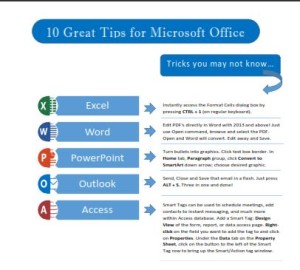Note: Requires Office 365 subscription. (For PowerPoint Online, PowerPoint Designer is available to subscribers when they are using files stored in SharePoint Online.)

Jazz Up Bulleted Lists with PowerPoint Designer
Here is my original, boring bulleted slide:

I want to jazz up my boring bullets and have Designer automatically give me the task pane to choose an image. It will analyze my list and display its best suggestions at the right. This can be any kind of list, whether actual steps or relevant points.
If my bulleted list is obviously steps or a process, Designer will display automatically, but if not, I can manually display design suggestions even if not a process list:
- Select the bulleted list

- Click Design tab, choose Design Ideas from Designer group

- Scroll through and click on the suggested Design Ideas in the task pane to insert into slide, such as:

Jazz up a Numbered List
I’ll get some different results if it is a numbered rather than bulleted list:
- Select the list
- Click the Numbering icon in the Paragraph group, Home tab
- The Designer will display with different suggestions…

- No more boring slide – totally rearranged with one mouse click!

Play around with these for interesting results. This is fast and easy but the suggestions may be limited and I may want more graphic selections. There’s an app for that, so to speak! Although a little more manual, I can achieve similar results with SmartArt like below…
Convert Bulleted List into Graphic with SmartArt
For more selections:
- Select the bulleted list
- Right click over selection, choose Convert to SmartArt from list
- Roll over available options to see Live Preview. If you want additional selections, click More SmartArt Graphics… at the bottom


- (Note you don’t get Live Preview here as the object change shows at right). After inserting your choice, any time you click on that part of the slide, the special tabs and groups for SmartArt will display on the Ribbon so you can edit the design as much as you want.
TIP: Which type of list should I use – bullets or numbering? Use a numbered list if you want order of priority or specific steps. Use the bulleted list for items that don’t need to be in order of process.
Think this is an awesome feature? Well it is, but it gets even better when you add photos, charts or other graphics, and let Designer make those slides sing! You can see them and use them too, with this blog:
Also, a couple of other blog posts that may interest you as they involve SmartArt and graphics with PowerPoint but don’t require Designer: https://gaylelarson.com/convert-slide-bullets-to-smartart-graphics/; and https://gaylelarson.com/powerpoint-quickstarter-for-research/
Let me know in the Comments below how you are using Designer or other graphic tools to liven up that presentation!




























































 Click to download great tips to speed up your Office projects.
Click to download great tips to speed up your Office projects.